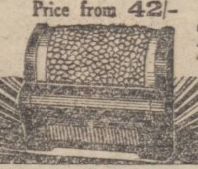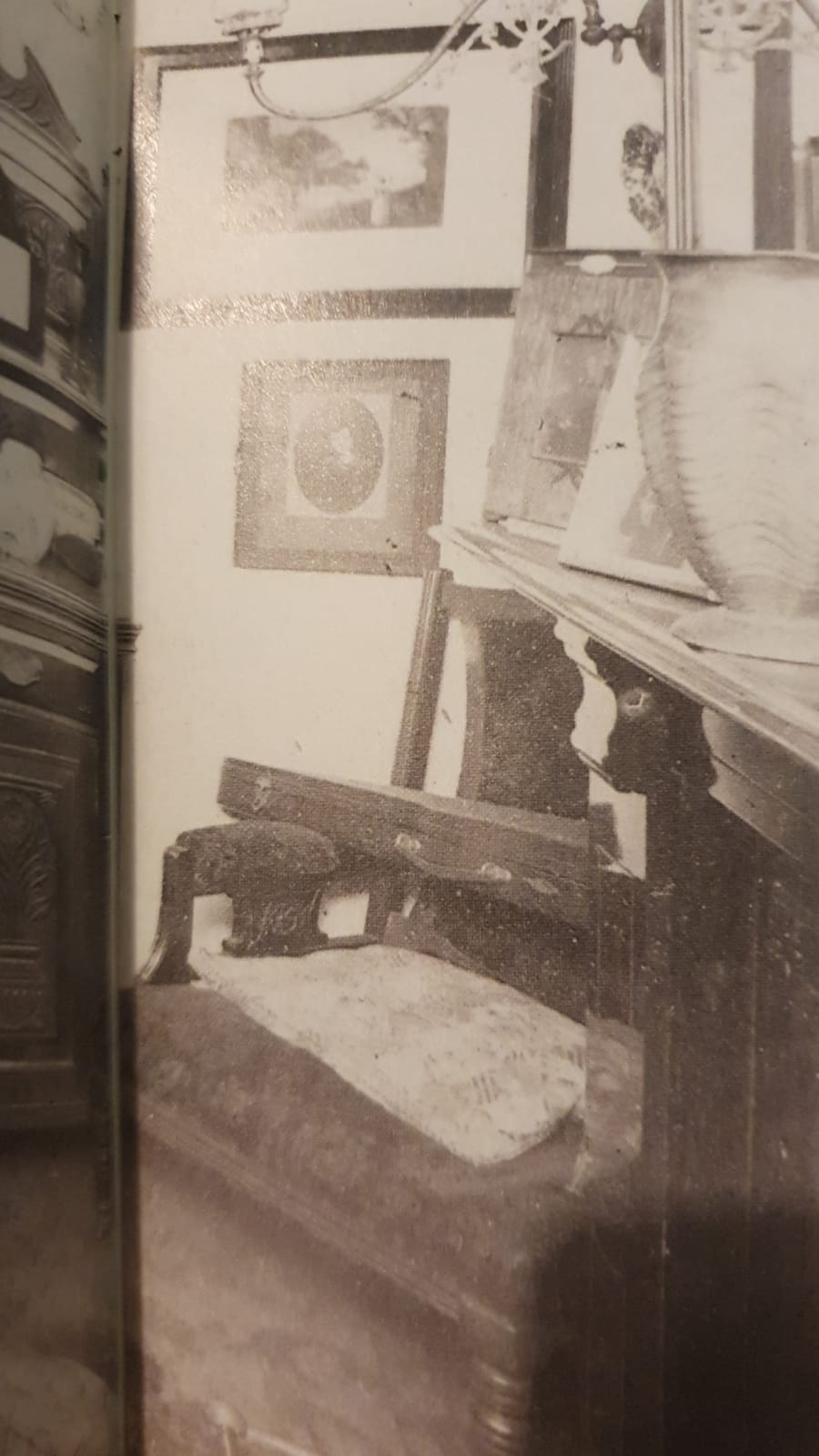[WORK IN PROGRESS]
A list of facts about the specifics of the case. I have left out the obvious details:
- Menlove Gardens was a relatively new estate and new homes were being built around the area regularly.
- The Wallaces used the back kitchen door for entry and exit into the home during the day for convenience of the tram. It was left off bolt.
- The church clock which the delivery boy timings are based on was checked each week. It was found that the churck clock was accurate at the time of the murder.
- The photograph in the kitchen was taken days after the murder.
- The fireplace in the parlour was a Sunbeam brand gas fire, with an appearance of fake coals to give a homely look. The bottom grill was removable.
- The valve to operate the gas fire in the parlour was on the right side of the fire (window side). This would need to be used to turn on or off the gas, or regulate the flame.
- The armchair upon which Wallace’s violin case is seen is to the left of the fireplace as you walk into the room.
- Later at night the practice was that Wallace would return home and enter through the front door using his key.
- If Julia and William went out together they would use the front door to exit and return.
- When the Wallaces left the house together they would take all the money in the house with them.
- Wallace told PC Fred Williams, the first officer on the scene, that the front door was bolted.
- The first officer on the scene PC Fred Williams noticed the mackintosh without Wallace’s prompting. Wallace confirmed it as his (also to Mrs. Johnston).
- Residents of Wolverton Street were able to open the doors of other houses on Wolverton Street using their own keys.
- On the 31st of December, less than a month before the murder, Julia had gone out and was late home due to accident on the railway lines. His concern was corroborated: He visited the police station to check for accidents, and Julia relayed his concern to Prudential colleague Albert Wood.
- Julia’s black cat had gone missing – it was missing from at least the time Wallace returned from the chess club the night before the murder. It turned up at around 23.00 on the night of the murder.
- Julia’s black cat was not originally her cat, she had looked after it while a couple she was friendly with were away. Julia bonded so much with the cat that they suggested she keep it.
- The chess club was founded by Wallace and James Caird who lived one street away (Letchworth Street).
- James Caird’s usual chess days were Thursdays, as he was a higher caliber player than Wallace. Thursdays were also the days that Parry’s drama club met at the same café.
- James Caird was not scheduled to attend the club on the night of the call (being a Monday), though members did often choose to attend on off-days including Wallace – which is how he had seen Gordon Parry there some months prior.
- On the night of the murder, a crowd gathered outside Wolverton Street as news had spread of the murder. James Caird turned up at roughly some stage between midnight and 1 AM after Wallace had been taken away to the station.
- PC Rothwell’s sighting of what he described as the distressed Wallace was after Wallace had just visited a client residing at the street he and Julia briefly lived in when first moving to Liverpool. She described him as joking and acting like his usual self. He then saw another client shortly after who also found him to be in a pleasant mood.
- Wallace never denied knowledge of Menlove Avenue. When given the address by Beattie (Menlove Gardens East) he immediately asked “is it Menlove Avenue?”
- On the way home, Caird asked Wallace if he would be going on the business trip, Wallace discussed with Caird how he planned to get to Menlove Avenue, and that he would make enquiries once in the general area. It was determined at the club by the members that the Gardens were off of Menlove Avenue.
- McCartney, Wallace’s opponent, asked for Wallace’s address so as to advise him of possible tram routes. Conceivably anybody at the chess club that night could then have had the knowledge required to commit this crime.
- Wallace’s natural tram route to Crewe’s home would not have been up Menlove Avenue, but along Allerton Road as described by Crewe. Crewe’s home was closer to Allerton Road, which you can check on Google Street View. The walk from a Menlove Avenue stop would be quite a bit futher.
- Wallace DID state to Hector Munro that he had said to Mrs. Johnston “her mackintosh, and my mackintosh”, NOT “a mackintosh”.
- When going to bed, Wallace would bring the Prudential cash box up with him.
- In the parlour, when alone the Wallaces would light only the gas jet closest to the window (right of the fireplace). When visitors were there, they would light both jets (one on each side of the fireplace).
- The crime scene was very heavily disturbed by investigating officers. Between pictures of the same room it is easy to see many differences. One major point of contention was the placement of a chair in the parlour near the sideboard/door depending on which photograph you looked at. The bathroom photos have far more major differences between them.
- The Liverpool Echo issued on the murder day was delivered at around 18.30 to 18.35. It was found open at its centre pages on the living kitchen table.
- The “disarray” in the bedroom was confined to the pillows on the bed being at the foot of the bed or by the window side of the fireplace – and the bedsheets being partly off.
- Julia’s handbag would have been removed from the scene, along with the coins at the base of the shelving on which the cash box was, and the broken cabinet door, by the time the photograph was taken.
- The broken cabinet door was not in good shape before being broken off, it had already broken once and been shoddily mended by William.
- No marks of blood were found outside of the parlour where the murder took place. Just the clot on the toilet pan and smear on the pound notes upstairs that I am told to disregard as transfer by modern experts.
- Ex-Prudential employee and friend of Gordon Parry, Joseph Caleb Marsden, had collected for a client named R. J. Qualtrough. According to Wallace, Marsden was let go due to financial irregularities (thieving).
- Gordon Parry’s alibi for the night of the call is contradicted by Lily Hall and her mother.
- Gordon Parry’s statement for the night of the murder is missing details according to John Parkes. Gordon states that after Lily Lloyd’s he went home and his statement ends at home. Parkes states Gordon had visited the garage that night.
- The cash box had three compartments. In the middle compartment was a crumpled dollar bill which had not been taken. Four 1d (1 penny) stamps were also left untouched in the box.
- Stolen from the cash box was “about £4”, comprised of a £1 treasury note, three 10 shilling treasury notes, about thirty or forty shillings in silver, a cheque for £5 17s, and a postal order for 4s 6d. All of this was the company’s (the Prudential’s) money.
The physical money converted to the modern decimal monetary format is about £4 to £4.50.
The postal order was worth £0.23 (23 pence). The cheque, payable to Wallace by the Prudential was for £5.85.
In totality including the cheque and postal order, £10.08 to £10.58 was missing from the box. - On the floor at the base of the bookshelf/shelving unit which the cash box was on top of, there was a half-crown and two separate shillings. A “half-crown” is 2s, 6d.
By the modern decimal monetary format, this is £0.23 (23 pence). - Julia’s body had a brooch around her neck, a wedding ring on one of her fingers, and in her corset a £1 note and 10 shilling note.
By the modern decimal monetary format, this is £1.50.
Before decimalization (our modern £X.XX monetary system with 100 pennies to a pound), £1 was worth 12 shilling (12 shillings being worth 240 pennies). “Old money” conversions by:
https://www.retrowow.co.uk/retro_britain/old_money/old_money_converter.html. - On the 21st, the day after the murder, Wallace paid in £10 11s to the Prudential in the form of a cheque, this is £10.55. Superintendent Crewe claimed that the police had taken £18, otherwise presumably the payment should have been £28 11s (£28.55).


